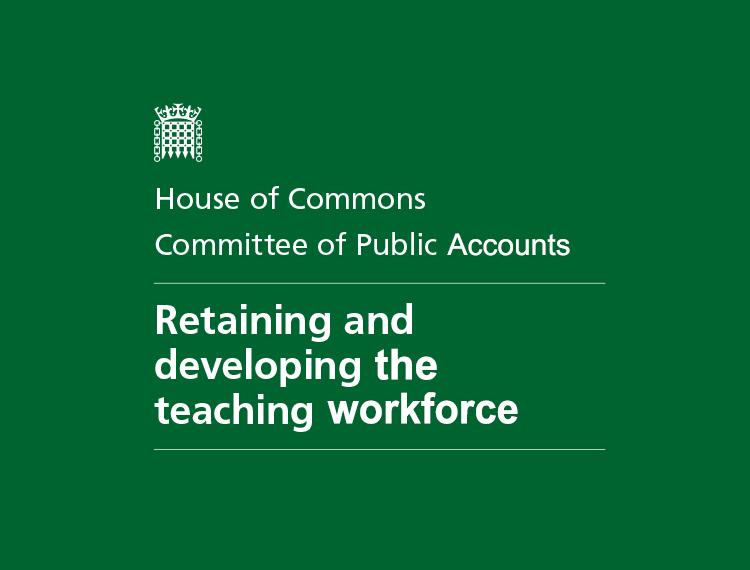Just 6% spent on training and developing existing teachers, compared to new teachers

Government failure on teacher numbers adds to pressure on schools – Public Accounts Committee Report
Growing sense of crisis for schools in England struggling to retain and develop teaching workforce.
A variety of factors have contributed to the growing sense of crisis for schools in England struggling to retain and develop their teachers.
Particularly worrying is that the number of secondary school teachers has been falling since 2010 and more teachers have been leaving the profession for reasons other than retirement since 2012.
Many teachers have cited heavy workloads as a reason for their departure. At the same time pupil numbers are rising and the Department for Education expects schools to make significant savings from using their staff more efficiently.
The Department should have been able to foresee this situation and take action to address it. By its own admission, the Department has given insufficient priority to teacher retention and development.
It has got the balance wrong between training new teachers and supporting the existing workforce, with spending on the former 15 times greater than on the latter.
The Department has a disparate collection of small-scale interventions but these are inadequate to address the underlying issues.
In addition, the quality of teaching and the level of teaching vacancies vary significantly across the country. However, the Department does not seem to understand the reasons for the variation or the different challenges that schools in different regions face.
The failure of the Department to get to grips with the number of teachers leaving puts additional pressure on schools faced with rising numbers of children needing a school place and the teachers to teach them.
COMMENT FROM PUBLIC ACCOUNTS COMMITTEE CHAIR MEG HILLIER MP:
“A crisis is brewing in English classrooms but Government action to address it has been sluggish and incoherent.
“It should have been clear to senior civil servants that growing demand for school places, combined with a drive for schools to make efficiency savings, would only build pressure in the system.
“Instead they seem to have watched on, scratching their heads, as more and more teachers quit the profession.
“Government must get a grip on teacher retention and we expect it to set out a targeted, measurable plan to support struggling schools as a matter of urgency.
“There are other troubling trends. In 2015/16 school leaders filled only around half of their vacancies with sufficiently qualified and experienced teachers.
“There are significant regional variations in vacancy levels and the quality of teaching also varies across the country. There is not enough good quality, continuing professional development available.
“There is a real danger that, without meaningful intervention from Government, these challenges will become an intractable threat to children’s education.”
 Comment from Kevin Courtney, Joint General Secretary of the National Education Union:
Comment from Kevin Courtney, Joint General Secretary of the National Education Union:
“The PAC has delivered a devastating critique of the Government’s failure to ensure that there are enough teachers working in England’s schools. The Department for Education has been asleep at the helm whilst the teacher supply crisis has moved from critical to catastrophic status. Fiddling whilst teacher supply burns, the Government has engaged in a number of small, localised initiatives which fail to begin to address the scale of the teacher supply problem.
“The PAC is correct in its analysis that excessive workload and inadequate pay is failing to attract, and driving teachers from, the profession at a time when school rolls will rise by over half a million extra pupils. Inadequate funding for schools will create a pressure keg of rising class sizes, creating even more unsustainable workload pressures for teachers and school leaders.
“What is most worrying is the PAC’s concern that the Department appears to have little clue about how to counter the exodus of experienced teachers from the profession. Whilst the Department’s workload challenge is a welcome step, it is entirely inadequate to hold back the tide of accountability pressures which engulf teachers and drives them to depart.
“What is needed, now, is bold and innovative thinking which must include radical changes to the accountability pressures on schools and a rise in teachers’ pay which will make it attractive to graduates.
“The PAC’s recommendation that the Government should work with others in the school sector to set out what is an acceptable level of teacher workload is to be welcomed. The National Education Union is willing to engage fully with Government in what will be a detailed and complex piece of work, defining the workload levels acceptable for teachers.”
A Department for Education spokesperson said:
“There are now a record number of teachers in our schools – 15,500 more than in 2010 – and last year, despite a competitive labour market with historic low unemployment rates and a growing economy, 32,000 trainee teachers were recruited. Retention rates have been broadly stable for the past 20 years, and the teaching profession continues to be an attractive career.
“We want to continue to help schools recruit and retain the best teachers. We are consulting on proposals to improve and increase development opportunities for teachers across the country and working with teachers, unions and Ofsted to tackle unnecessary workload with specific support for teachers at the start of their careers. Alongside this we continue to offer financial incentives to attract the brightest and best into our classrooms.”
“Teacher recruitment is extremely important and in September 2017, 32,710 trainees started an Initial Teacher Training course. We want to do all we can to help schools with recruitment, which is why we are working closely with the higher education sector to ensure they can continue to attract the best and the brightest into the profession. We also have a range of generous bursaries designed to recruit more teachers in important subjects such as maths and physics.
“We are creating a free website for schools to publish vacancies to help reduce costs and make it easier for aspiring and current teachers to find new posts.
“We are aware that the workload is challenging for many teachers which is why we have a teacher workload action plan. This makes a commitment for targeted support to tackle excessive workload where it is most needed, and will include specific support for teachers in the early part of their careers.”
CONCLUSIONS AND RECOMMENDATIONS
The Department has failed to get a grip on teacher retention. The teaching workforce increased by 15,500 (3.5%) from 441,800 in November 2010 to 457,300 in November 2016. However, this overall rise masks the fact that the number of teachers in secondary schools fell by 10,800 (4.9%) from 219,000 in 2010 to 208,200 in 2016. In primary schools the pupil-teacher ratio remained fairly constant between 2011 and 2016, but in secondary schools the ratio increased, from 14.9:1 to 15.6:1 over the same period, even though pupil numbers fell. The Department forecasts that secondary school pupil numbers will increase by 540,000 (19.4%) between 2017 and 2025, and that pupil-teacher ratios will continue to rise.
The number of qualified teachers leaving for reasons other than retirement increased from 6% (25,260) of the qualified workforce in 2011 to 8.1% (34,910) in 2016. The Department does not understand why more teachers are leaving the profession, and does not have a coherent plan to tackle teacher retention and development. It has a range of relatively small-scale initiatives but has not communicated these adequately to schools.
The Department says it will be streamlining its approach, and that it was developing a plan that it expected to be ready by the end of 2017-18.
It also acknowledges that the balance of investment has not been right, with £555 million spent each year on training new teachers and just £36 million spent on programmes to retain and develop teachers.
Recommendation: The Department should set out and communicate by April 2018 a coherent plan for how it will support schools to retain and develop the teaching workforce. The plan should include what the Department is aiming to achieve and by when, the interventions it will use to achieve its aims, and how it will measure success (including the desired impact on the rate of teachers leaving the profession).
Workload is the main reason why teachers leave the profession but the Department has not set out what impact it is seeking to achieve from its interventions on this issue. Workload is a significant barrier to teacher retention. The Department’s own survey, published in February 2017, found that classroom teachers and ‘middle leaders’ worked 54.4 hours on average during the reference week. Head teachers are concerned about increasing workload which has a detrimental effect on the quality of teaching and teachers’ wellbeing. They highlighted that increasing contact time so that teachers are teaching classes for a high proportion of the time, larger class sizes and the pace of change in assessment and the curriculum are the main factors which have increased workload.
The tools published by the Department in 2015 to help schools reduce workload have had very limited impact – only half of schools have used the tools, of which a third reduced workload (by up to two hours per teacher per week). Alongside the results of its survey, in February 2017, the Department published an action plan to reduce unnecessary workload but it has not indicated the extent of change it expects to see as a result. We do not expect the Department to prescribe how many hours teachers should work but do expect it to understand and have a view on the relationship between workload and retention. We also expect the Department to be mindful of the impact on workload of decisions that schools have necessarily had to take to make efficiency savings, such as increasing class sizes and contact time, and of its own decisions, such as regular curriculum and assessment changes.
Recommendation: The Department should work with others in the school sector to set out what is an acceptable level of teacher workload, monitor through its periodic surveys of teachers the impact of its actions to reduce unnecessary workload, and identify possible further interventions.
Schools are struggling to recruit teachers of the right quality, particularly in some subjects and some parts of the country. During 2015/16 school leaders filled only around half of their vacant posts with qualified teachers with the experience and expertise required. Schools are struggling to recruit teachers in science, maths and modern foreign languages in particular, and these subjects are expected to be most affected by the UK leaving the European Union. The extent of teacher vacancies also varies across the country. In 2015 the North East had the lowest proportion of secondary schools reporting at least one vacancy (16.4%); the highest proportions were in outer London (30.4%), the South East (26.4%) and the East of England (25.3%). The Department stopped the National Teaching Service, which aimed to place teachers into underperforming schools that struggled with recruitment and retention, after the pilot matched only 24 teachers to schools in the North West. We are also concerned about the high cost for schools of recruitment.
The Department plans to launch a pilot of a web-based national teacher vacancy service in spring 2018, to reduce the cost of recruitment and generate better data on vacancies. The Department also says it is working with the Crown Commercial Service to develop a framework contract for schools as a cheaper alternative to using recruitment agencies. There is a large pool of trained teachers (nearly 250,000) who are not currently teaching and could fill vacancies. Barriers to schools employing returning teachers include the challenge of timetabling when teachers work flexibly and schools’ concerns that returners may lack up-to-date subject knowledge.
Recommendation: The Department should help schools more to recruit teachers of the right quality. In particular, it should:
- set out its plans for the national vacancy service including the scope, timetable and budget;
- report back to us by June 2018 on the results of the national vacancy service pilot;
- write to us by June 2018 setting out the actions it has taken to control agency fees and the results achieved; and
- work with the schools sector to share good practice in implementing flexible working to help attract former teachers to return to the profession.
We are concerned that the cost of living, in particular housing costs, is making it difficult to recruit and retain teachers in some parts of the country. The National Audit Office’s survey of school leaders found that, after workload, factors affecting the cost of living (for example house prices) are the second most significant barrier to teacher retention, with 42% of respondents reporting it as a barrier. The cost of living in certain parts of the country makes it even more difficult to attract and retain teachers. Committee Members highlighted the high cost of housing in Oxfordshire and Cambridgeshire as a barrier to retaining teachers locally. In 2015 the highest proportions of secondary schools reporting at least one vacancy were in outer London and the South East, where house prices are high.
The Department has given schools flexibility to vary pay and allowances to help them recruit and retain teachers; but many are not using these flexibilities, which is not surprising given their financial pressures and efforts to find efficiencies. The Department says it is willing to talk to any schools with proposals to support teachers with housing, but it does not have any particular initiatives to address cost of living issues. Its pilot scheme, which involved offering teachers £10,000 as an incentive to move to the North West, had little take up. The Committee questioned whether the Department had considered relocation costs when it fixed the incentive payment at £10,000.
Recommendation: The Department should set out how it will take account of the housing requirements for teachers, particularly in high-cost areas, in order to support recruitment and retention. It should take a more strategic role, particularly as this is an issue that goes across Whitehall, when considering initiatives to support teachers to ensure that funding for these has a real impact.
The Department could not explain why the quality of teaching varies so much across the country, and what action it would take to improve quality in the Midlands and the North of England in particular. More pupils are now in schools where Ofsted has rated the quality of teaching, learning and assessment as outstanding or good – 90% of primary school pupils and 82% of secondary school pupils in 2016. However, in five of the nine English regions, all in the Midlands or the North of England, more than 20% of pupils were in secondary schools rated as requires improvement or inadequate for teaching, learning and assessment.
Across England 88,000 pupils were in schools where teaching, learning and assessment was rated as inadequate. The proportion of pupils in secondary schools rated as inadequate for teacher, learning and assessment increased with the deprivation of an area. We pressed the Department on why there are such regional differences in teaching quality and what it is doing to address them, but it could not provide any satisfactory explanation.
Recommendation: The Department should conduct more work to understand why there are regional differences in teaching quality (for example by engaging more with school leaders in those regions where quality could be most improved) and, in light of its findings, set out how it proposes to improve the quality of teaching in the Midlands and the North of England specifically.
Teachers are not getting enough good quality continuing professional development throughout their career, which has implications for teacher retention and quality and ultimately for pupil outcomes. Continuing professional development (CPD) is essential for the workforce to keep up to date with current practices and meet expected standards. The Department does not collect data, but research by the Educational Policy Institute found that on average teachers in England spent only four days a year on CPD in 2013 compared with an average of 10.5 days across the 36 countries covered by the analysis. Head teachers stressed to us how vital it is for teachers to undertake good quality CPD at all stages of their career not just in the first few years. They highlighted time and cost as the main barriers to teachers undertaking CPD, in line with the findings of the National Audit Office’s survey of school leaders. The Department acknowledges that more needs to be done to increase the amount and quality of CPD that teachers undertake.
Recommendation: The Department should write to us by April 2018 setting out its plans for improving the quality of CPD available to teachers, its expectations for how much CPD teachers should undertake and how improvements in CPD will be paid for.
The Department has not made clear what it means by its aim of improving social mobility through its 12 opportunity areas and how it will measure progress. The Department has created 12 ‘opportunity areas’ that will receive extra funding and other support with the aim of improving social mobility and ensuring that children in these parts of the country have opportunities to reach their potential. The programme is at an early stage with the opportunity areas currently developing local plans. We recognise that improving social mobility is a long-term goal, that the Department has commissioned a ‘process evaluation’ to report by summer 2018, and that it plans a further study to examine the impact of the opportunity areas. However, the Department has not defined measures of success for the programme, and says that it is relying on local areas to define their own priorities. The Department did not explain how the opportunity areas fit with other government programmes focusing on particular geographical areas, such as the Northern Powerhouse.
Recommendation: The Department should write to us by April 2018 to explain in more detail its aims for the opportunity areas over both the short term and long term.
The full text of the Committee’s Conclusions and Recommendations is included here.
Evidence relating to this Report can be found here.











Responses